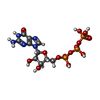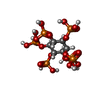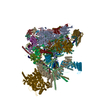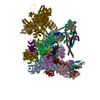+Search query
-Structure paper
| Title | Structural insights into spliceosome fidelity: DHX35-GPATCH1- mediated rejection of aberrant splicing substrates. |
|---|---|
| Journal, issue, pages | Cell Res, Vol. 35, Issue 4, Page 296-308, Year 2025 |
| Publish date | Feb 28, 2025 |
 Authors Authors | Yi Li / Paulina Fischer / Mengjiao Wang / Qianxing Zhou / Aixia Song / Rui Yuan / Wanyu Meng / Fei Xavier Chen / Reinhard Lührmann / Benjamin Lau / Ed Hurt / Jingdong Cheng /   |
| PubMed Abstract | The spliceosome, a highly dynamic macromolecular assembly, catalyzes the precise removal of introns from pre-mRNAs. Recent studies have provided comprehensive structural insights into the step-wise ...The spliceosome, a highly dynamic macromolecular assembly, catalyzes the precise removal of introns from pre-mRNAs. Recent studies have provided comprehensive structural insights into the step-wise assembly, catalytic splicing and final disassembly of the spliceosome. However, the molecular details of how the spliceosome recognizes and rejects suboptimal splicing substrates remained unclear. Here, we show cryo-electron microscopy structures of spliceosomal quality control complexes from a thermophilic eukaryote, Chaetomium thermophilum. The spliceosomes, henceforth termed B*, are stalled at a catalytically activated state but prior to the first splicing reaction due to an aberrant 5' splice site conformation. This state is recognized by G-patch protein GPATCH1, which is docked onto PRP8-EN and -RH domains and has recruited the cognate DHX35 helicase to its U2 snRNA substrate. In B*, DHX35 has dissociated the U2/branch site helix, while the disassembly helicase DHX15 is docked close to its U6 RNA 3'-end substrate. Our work thus provides mechanistic insights into the concerted action of two spliceosomal helicases in maintaining splicing fidelity by priming spliceosomes that are bound to aberrant splice substrates for disassembly. |
 External links External links |  Cell Res / Cell Res /  PubMed:40016598 / PubMed:40016598 /  PubMed Central PubMed Central |
| Methods | EM (single particle) |
| Resolution | 2.8 - 3.5 Å |
| Structure data | EMDB-62841, PDB-9l5r: EMDB-62842, PDB-9l5s: EMDB-62843, PDB-9l5t:  EMDB-62844: Cryo-EM structure of the thermophile spliceosome (state B*Q2 focus DHX15) |
| Chemicals |  ChemComp-M7M:  ChemComp-MG:  ChemComp-GTP:  ChemComp-IHP:  ChemComp-ZN: |
| Source |
|
 Keywords Keywords | SPLICING/RNA / Spilceosome / DHX15 / DHX35 / GPATCH1 / SPLICING-RNA complex |
 Movie
Movie Controller
Controller Structure viewers
Structure viewers About Yorodumi Papers
About Yorodumi Papers









 chaetomium thermophilum (strain dsm 1495 / cbs 144.50 / imi 039719) (fungus)
chaetomium thermophilum (strain dsm 1495 / cbs 144.50 / imi 039719) (fungus)